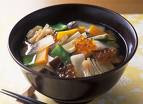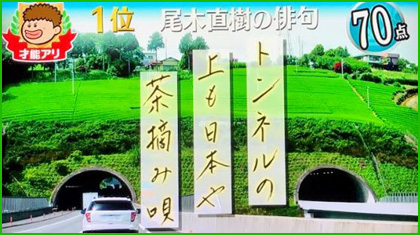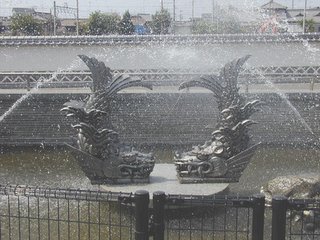[ . BACK to WORLDKIGO TOP . ]
::::::::::::::::::::::::::::::::::::::::::::::::::::::::::::::::::::::::::::::::::::::::::::::::::::
Devil's-tongue (konnyaku)
***** Location: Japan
***** Season: Various, see below
***** Category: Plant and Humanity
*****************************
Explanation
Konnyaku, konjac, konjak
Amorphophallus rivieri
refers to the plant and the food prepared with it.
Elephant foot, elephant jam, snake palm and voodoo lily are English names for it.
konnyaku uu 蒟蒻植う (こんにゃくうう )
planting konnyaku
kigo for late spring

konnyaku no hana 蒟蒻の花 (こんにゃくのはな)
konyaku flowers
kigo for mid-summer
.................................................................................
kigo for mid-winter
konnyakudama 蒟蒻玉(こんにゃくだま)konnyaku root
konnyaku horu 蒟蒻掘る (こんにゃくほる) digging for konnyaku roots
konnyakudama horu 蒟蒻玉掘る(こんにゃくだまほる)
Konnyaku-Knolle, Konjak-Knolle
 Farmhouse in Gunma, drying konnyaku
konnyakudama hosu
Farmhouse in Gunma, drying konnyaku
konnyakudama hosu 蒟蒻玉干す(こんにゃくだまほす)to dry konnyaku roots
... konnyaku hosu 蒟蒻干す(こんにゃくほす)
konnyaku no sudareboshi 蒟蒻の簾干(こんにゃくのすだれぼし)to dry konnyaku roots on a bamboo shelf
konnyaku sudare 蒟蒻すだれ(こんにゃくすだれ)bamboo shelf to dry konnyaku roots
tooji konnyaku 冬至蒟蒻(とうじこんにゃく)
konnyaku for the winter equinox
.................................................................................
frozen konnyaku
kigo for late winter
konyaku koorasu 蒟蒻氷らす (こんにゃくこおらす)
freezing devil's tongue root jelly
konyaku koorasu 蒟蒻凍らす(こんにゃくこおらす)、
koori konyaku 氷蒟蒻(こおりこんにゃく)
preparing frozen konyaku, koorikonyaku tsukuru
氷蒟蒻造る(こおりこんにゃくつくる)
:::::::::::::::::::::::::::::::::::::::::::::::::::::::::::::::::::::::::::::::::::::::::::::::::::
The following are not kigo.
konnyaku コンニャク devil's-tongue
Amorphophallus konjac
konnyaku imo コンニャクイモ(蒟蒻芋)
Konnyaku-Potato
konnyaku, konyaku こんにゃく food ... gelatinous food made from devil's-tongue starch.
A plant in the sweet potatoe family. It is eaten in China, Burma, Korea and other Asian countries.
In Japan more than 90 % are grown in
Gunma prefecture, second in Tochigi and third in Ibaraki. So the North of the Kanto plain grows more than 97% of this plant.
It originated in India and the Indonesian peninsula.
It takes about 5 to 6 years to make the root grow before it starts to produce a flower. And after the flowering, the root dries out. The flower can be as big as 2 meters.
It is rich in fibers and good for a diet. It is alkali.
one of the Chinese medicine.
::::::::::::::::::::::::::::::::::::::::::::::::::::::::::::::::::::::::::::::::::::::::::::::::::::
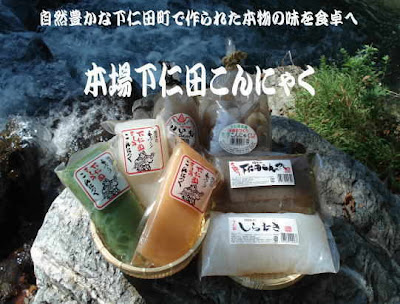 WASHOKU
WASHOKU
Gunma and Shimonita Konnyaku 下仁田こんにゃく
Usually the konnyaku is ground into flower, from which jelly is prepared. But here the raw root is grated and jelly produced from it. namaimo konnyaku
本場下仁田生芋こんにゃく
It also comes in different colors for sashimi, white and green. For auspicious occasions it is colored in white and red (koohaku こんにゃく紅白寿セット).
shimikonnyaku, shimi-konnyaku 凍みこんにゃく
frozen Konnyaku
naturally freeze-dried by the sun and the cold wind of Gunma.
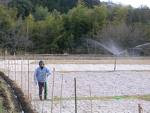
A big brick-like piece is put into a wooden cutter and pressed by hand into 42 slices of about 2 cm. These are layed out in the rice fields by the womenfolk and dried on the fields, for one month, watered every day and frozen at night. It becomes a thin slice of whitish substance.
It it does not come into contact with water after drying completely, it might keep as long as 50 years. So it was a special food for farmers to keep for times of famine.
It can be used in the frypan or even as tempura.
As a sponge, some women use it to wash the face and body.
:::::::::::::::::::::::::::::::::::::::::::::::::::::::::::::::::::::::::::::::::::::::::::::::::::::
Yamato kushi konnyaku 串こんにゃく Konjak on skewers
from Nara prefecture
:::::::::::::::::::::::::::::::::::::::::::::::::::::::::::::::::::::::::::::::::::::::::::::::::::::
Food made from konnyaku starch
It is produced to a jelly-like square of gray-brown color and some are whitish and not much taste.
Boiled in oden hodgepodge it is eaten with strong mustard. It contains to 97 percent of water and has no calories, but a lot of fibers and is good for a diet. The fiber contains glucomannan.
Before eating it the bitterness has to be removed by immersing it in ash water for a few days. 灰汁抜き
Konnyaku is mostly eaten in oden hodgepodge. Also in soups like miso soup or pork soup and other boiled food (nimono). its noodles are used for sukiyaki.
Raw it is eaten as sashimi
with miso-vinegar-dressing or wasabi soysauce.
aka konnyaku 赤こんにゃくred konnyaku
red yams
It
looks almost like maguro sashimi, often cut in triangular pieces.
It looks like chilli pepper red, but that is not the reason.
It relates back to Oda Nobunaga.
In Omi,the celebrations of Sagichoo 左義長 to preserve the peace of the country are held every year. Nobunaga had been to this ceremony and danced with the young people, wearing the red robes of a woman. Well, he liked the color red so much he even ordered the people of Omi to dye the konnyaku with this color. It is oxydized iron that makes it red.
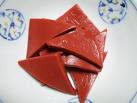
speciality of Omi Hachiman, Ōmihachiman 近江八幡, Shiga prefecture
Daruma Museum :
Sagichoo Festival 左義長
ito konnyaku 糸蒟蒻 Konjak noodles
shirataki 白滝( しらたき) "white waterfall" is also used for oden and
nikujaga meat and potatoe stew. Also sukiyaki.
ito konnyaku is thicker and made in Kansai by cutting the jelly.
shirataki is made in Kanto by pressing the jelly through holes of a pressure right into the hot water.
Now there are also shirataki noodles with a tofu mixture on the marked, which contain some carbohydrates.
. . . CLICK here for Photos !
Faden-Konnyaku, Nudelart.
tama konnyaku 玉こんにゃく/ 玉コンニャク
konnyaku balls
tamakon 玉コン, gelatine balls
konnyaku yamagata
Thre on a skewer. Boiled in oden broth or soy sauce broth and eaten with hot mustard
They are sold prepared with or without broth.
With a broth of surume they make a good snack for a cup of ricewine.
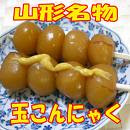 . . . CLICK here for Photos !
. . . CLICK here for Photos !
speciality of Yamagata, where they are prepared for large crowds of people at festivals and events.
konnyaku serii コンニャクゼリー fruit jelly with konjak
It is also made into fruit jelly in little plastic cups, called
konjac candy.
The starch is made into a powder and mixed with fruit juice.

"Mini-Cup-Jellys"
::::::::::::::::::::::::::::::::::::::::::::::::::::::::::::::::::::::::::::::::::::::::::::::::::::
konnyaku ko 蒟蒻粉konjak flower
Konjakmehl, Konjacmehl
konnyaku flower is mannan マンナン、Konjac Mannan
Water-soluble knojac mannan substance is capable of undergoing gelation when heated in an aqueous alkaline solution.
Tofu and konnyaku change from gel to a spongy structure by freezing-thawing because of the denaturation of protein (tofu) or mannan (konnyaku).
used for perfect cookie パーフェクトクッキー
:::::::::::::::::::::::::::::::::::::::::::::::::::::::::::::::::::::::::::::::::::::::::::::::::::::
Other use of konnyaku
To impregnate paper or cloth against water
耐水性高分子素材
In the House of Horrors
お化け屋敷のコンニャク
It can hang down and swish off the face of a fearful visitor.
*****************************
Worldwide use
Konjak-Wurzel
Wunderwurzel Glucomannan, Wirkstoff der Knolle (
Glucomannan)
Geliermittel Glukomannan
Konjacmehl
Gelee-Süßwaren "Mini-Cup-Jellys"
Diese gallertartigen Süßigkeiten können sich aufgrund ihrer Form und Beschaffenheit sehr leicht im Rachenraum festsetzen und zu Erstickungsanfällen führen.
source : waswiressen.de
Mehr : www.konjak.de
*****************************
Things found on the way
History
When Toyotomi Hideyoshi (1536-1589) had the castle in Hizen domain, Nagoya 名護屋城(Saga prefecture) built in 1592 within eight short months as a base for this Korean invasion, the master stone mason suddenly fell very ill with stomac ace. His wife went to the local temple and poored cold water over herself and prayed for his getting better. She had the vision that someone was helping her and giving her advise for a good medicine. When she went home there was one root of konnyaku under her pillow. She prepared it and had her ill husband eat it and what do you say ... he recovered in no time! And the castle could be built just in time as planned. When the others heared of this story, most daimyo who had been there took some of the local konnyaku roots home with them and had them plant in their own domaines too as medicine.
The stone wall is still left to this day.
:::::::::::::::::::::::::::::::::::::::::::::::::::::::::::::::::::::::::::::::::::::::::::::::::::::
Konnyaku Mondo こんにゃく問答 rakugo story
source : こんにゃく問答
by Koyuza Sanyutei
synonym for
ein unsinniger Dialog, eine dumme Antwort
quote
A Classic Tale
From the Rakugo Storyteller’s Repertoire
The Joshu region of Japan is known for the dry winds that bluster down from the mountains and for the konnyaku plants that grow in the fields. The plants’ potato-like tubers are sliced and dried, then boiled and shaped into deliciously chewy patties, which are also called, simply, konnyaku.
In southern Joshu, on the outskirts of the town of Annaka, there lived a konnyaku maker named
Rokubei. Born and raised in Edo, he might have spent his whole life there, but a tendency to drink heavily, gamble unluckily, and frequent houses of ill repute made that untenable. Having exhausted a lifetime’s worth of credit in just 20-some years, he left the big city behind, worked hard to learn his present trade, and was eventually able to set up his own shop. He had a certain charisma and soon came to be seen as the unofficial head of his neighborhood. Occasionally, young men who had been living too fast in Edo would show up on Rokubei’s doorstep and he never failed to help them.
Hachigoro showed up in somewhat worse shape than most. Not only had he parted with his last yen, but due to a bout of venereal disease, he had lost all of the hair on his head as well. Rokubei, though, saw this loss as a possible advantage and said, "I think I may have a job tailor-made for you."
The nearby temple had been without a resident monk, without a bonze, that is, for some time.
Gonsuke, the temple boy kept the place tidy, but he was too young to take over as head bonze. Hachigoro didn’t know a sutra from a koan, but he was old enough. "And besides," added Rokubei, "you’ve got the look. Your head is pre-shaved! Come on, you can wing the rest."
Thus Hachigoro was appointed head bonze. The original plan was to have Gonsuke give him a crash course in the basics of Buddhist ritual and, in fact, they did manage to pull off a funeral together. However, they also spent quite a bit of time over dice, with Hachigoro teaching Gonsuke the basics of gambling ritual. As a result, novice Head Bonze Hachigoro was grossly unprepared when, one bright morning, a traveling bonze appeared at the gate and issued a mondo dialogue challenge.
Gonsuke met this real, bona fide bonze out at the gate and returned to the temple pale and short of breath. "Now we’re in trouble," he told Hachigoro. "You can’t turn him away. In Zen Buddhism, and this is a Zen temple, you know, if a bonze is challenged to a mondo dialogue, he must accept. And if defeated, he must hand his temple over to the challenger." Hachigoro rubbed his bald head and whined, "You mean he’s trying to drive me out of my own temple? That’s not fair. I don’t do mondo!"
The two decided to do the only sensible thing. Hachigoro hid in the closet and Gonsuke told the traveling bonze that his master was out of town. The bonze replied that he would return tomorrow, and the next day if necessary. In fact, he would come every day for the next year.
When the coast was clear, Hachigoro emerged from the closet, sneezed, and declared that they had better take the statue of Buddha and the other paraphernalia, skip town, and sell everything to an antique dealer. He and Gonsuke were busy packing when Rokubei came by to see how ritual practice was going. "Zen dialogue?!" he guffawed, "What are you worried about?
That mondo mumbo jumbo, how hard can it be?"
"Harder than konnyaku, I’m afraid,"
sighed Gonsuke.
"No sweat. I bet the guy’s bluffing. I’ll tell you what: tomorrow I’ll dress up as head bonze and we’ll see if he’s for real."
The statue of Buddha was returned to its pedestal. Next morning when the traveling bonze arrived as promised, Rokubei was waiting for him in the main hall, seated in full regalia with his head freshly shaved.
After a deep bow, the challenger posed his first question: "When wind blows through a pine tree, a unique sound is made. Respectfully I ask, is it the voice of the wind, or the voice of the pine?"
Rokubei hadn’t a clue, so he said nothing and simply glared. At first, the traveling bonze was puzzled, but then it dawned on him that this was surely the advanced, deeply esoteric "silent mondo" technique. He nodded, closed his eyes for a moment, then glaring back, he placed both hands in front of his chest and made a circle with his thumbs and forefingers.
Rokubei shook his head and held up both arms in a big circle. Next the traveling bonze thrust out both hands with his 10 fingers spread. Rokubei responded by thrusting out his right hand only, fingers spread. The challenger bowed in acceptance, and held out his right hand with just three fingers raised. Rokubei threw his head back and, with his right hand, pointed to his right eye. With that, the challenger sighed, stood up, and walked out.
Gonsuke had been watching the entire mondo from a crack between the sliding doors. Still, he didn’t know what to make of the exchange, so he ran after the departing bonze and asked how it had gone.
"Well, I made a circle in front of my chest, asking your master, of course, about the state of the human soul. He responded with a large circle, meaning "as spacious as the spheres." Then I inquired about the Ten Directions of the world. He indicated that the Five Great Laws would preserve them. When I asked about the Three Great Teachings, he pointed out that they are always here right before our eyes. That’s when I realized he was far too enlightened an opponent for me. I’ll return years from now, once I’ve attained a deeper understanding."
Gonsuke was truly impressed. Who would have imagined that Rokubei, the konnyaku maker, was a Zen expert!?
But back inside the temple, he found Rokubei fuming:
"That bastard must have passed by my shop and seen me working or something. He starts his mondo thing, but then stops, gives me a good looking over and a knowing little nod.
I could tell he recognized me, dammit, because
he made the shape of a konnyaku with his fingers.
He was saying,
’Your konnyaku’s about this small,’
so I made a jumbo konnyaku コンニャク with both arms to show him how wrong he was.
Then he asks, ’How much for 10?’
So I show him, you know, 5 yen.
Now get this!
That bonze asked for a stinking discount —
’Give ’em to me for 3 yen.’
Well, that’s when I told him to stick it in his eye!" アカンベエ
Source :int.kateigaho.com
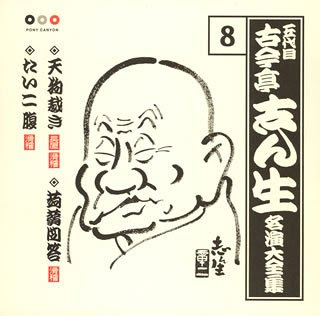
蒟蒻(こんにゃく)問答
Konnyaku Mondo
*****************************
HAIKU
こんにゃくもお十二日はつ時雨
konnyaku mo o-juu-ni nichi zo hatsu shigure
for festive jelly too
the venerable Twelfth Day...
first winter rain
Kobayashi Issa
Tenth Month, 12th day is the Death-Day anniversary of the great poet, Bashoo. This day is also called "First Winter Rain Anniversary" (shigure ki). Shinji Ogawa explains that konnyaku might be translated, "devil's tongue jelly."
Konnyaku is kneaded devil's tongue root (Amorphophallus Rivieri).
(Tr. David Lanoue)
:::::::::::::::::::::::::::::::::::::::::::::::::::::::::::::::::::::::::::::::::::::::::::::::::::
Oden Konnyaku and Matsuo Basho
He was fond of konnyaku oden and sashimi.
 蒟蒻の刺身もすこし梅の花
蒟蒻の刺身もすこし梅の花
konnyaku no sashimi mo sukoshi ume no hana
just a few
slices of konnyaku -
and some plum blossoms
Matsuo Basho in the year Genroku 9, Spring:
In memoriam of his disciple Kyorai, when they were having a vegetarian memorial repast in his honor. Some slices of konnyaku sashimi were placed on the altar in his honor.
. Temple Eigen-ji 永源寺
Stone memorial of this haiku
plum blossoms
and some sashimi of
devil's tongue
Tr. Robin D. Gill
a few slices of
konnyaku and
plum blossoms
source : www.oller.net - Baieido
The Japanese word
MO indicates that there was a bit of this and a bit of that:
konnyaku no sashimi mo sukoshi
ume no hana mo sukoshi
quote
glass noodles'
few slices of fish
plum blossoms
Tr. Reichhold
Reichhold's comment:
"This poem was enclosed in a letter of condolence."
source : Larry Bole
.............................................................................
蒟蒻に今日は売り勝つ若菜哉
konnyaku ni kyoo wa urikatsu wakana kana
Konnyaku
Today sold-out
By young herbs.
Tr. Nelson / Saito
Written on the seventh day of the first lunar month
元禄6年1月7日, Basho age 50
. WKD : the seven herbs rice gruel .
nanakusagayu 七草がゆ Kayu 粥 rice gruel now prepared on January 7.
MORE - hokku about food by
. Matsuo Basho 松尾芭蕉 - Archives of the WKD .
:::::::::::::::::::::::::::::::::::::::::::::::::::::::::::::::::::::::::::::::::::::::::::::::::::::
しぐるゝや蒟蒻冷えて臍の上
shigururu ya konnyaku hiete heso no ue
such a cold drizzle -
the devil's tongue gone cold
on my navel
Masaoka Shiki
(It is used as a kind of compress to prevent catching cold or stomach disorder.)
::::::::::::::::::::::::::::::::::::::::::::::::::::::::::::::::::::::::::::::::::::::::::::::::::::
三日月に蒟蒻玉を掘る光
mikazuki ni konnyaku tama o horu hikari
under the shine
of a crescent moon we dig
for konnyaku roots
Hagiwara Bakusoo (1894-1965) 萩原麦草
:::::::::::::::::::::::::::::::::::::::::::::::::::::::::::::::::::::::::::::::::::::::::::::::::::::
山干しの蒟蒻に来る山の影
yamaboshi no konnyaku ni kuru yama no kage
the shadow of the mountain
reaches the drying konnyaku
on the mountain slope
Nozaki Yurika 野崎ゆり香
*****************************
Related words
*****
WASHOKU : INGREDIENTS
:::::::::::::::::::::::::::::::::::::::::::::::::::::::::::::::::::::::::::::::::::::::::::::::::::













